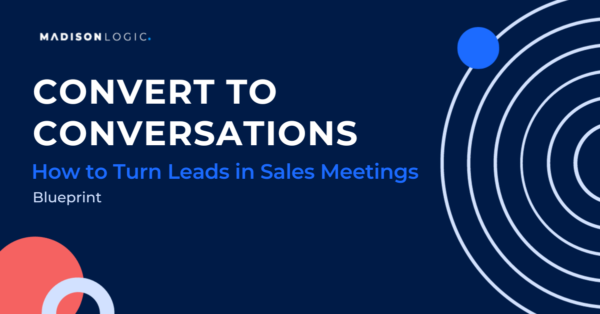
From Leads to Discussions: How You Can Drive Leads to Sales Meetings

Face it: B2B sales and marketing are changing. There’s no single decision-maker anymore—instead, you need to capture the attention of six to ten members of the buying committee that each has their own set of individual pain points and concerns. Sales cycles are also longer, offering more opportunities for leads to get stuck in the pipeline.
Understanding why leads get stuck in your sales pipeline relies on a better understanding of the state of the B2B marketplace and the buying journey itself. Buyers have become increasingly more independent, conducting their own research online and completing most of the decision-making process before even speaking to a salesperson. Where sales outreach was once characterized by a “Smile and dial” or “Call until you hear ‘No'” approach, salespeople must now consider a more impactful way to reach out to leads to drive important conversations that ultimately close the deal.
The answer relies on marketing and sales teams working in tandem to deliver the right message at the right time with personalized messaging that capitalizes on the buyer’s intent and concerns. That’s why Johanna Shirman, Senior Marketing Manager at Madison Logic, and Chris Malito, Vice President of Sales (East Coast) at Madison Logic, recently sat down to discuss the tactics for driving leads toward successful sales meetings for the “From Leads to Discussions: Successful Tactics for Driving Sales Meeting” webinar. Here are some of their key takeaways.
The Shift Toward Account-Based Marketing Strategies Requires Customized Messaging
The transition from single decision-maker marketing to account-based marketing (ABM) strategies stresses how crucial personalized messaging is as you engage with the entire buying committee.
A common pitfall of B2B marketing lies with the evolution of the self-educated buyer. The reality is that marketers no longer control the pace of their audience’s research process. These self-educated buyers already know about your platform and services, and are most likely looking your brand up alongside your competitors. And as a recent Gartner study cites that salespeople only have roughly 5% of a buyer’s time during the entire buyer’s journey, there’s an additional sense of urgency to meet buyers exactly where they are within the discovery phase and capture their attention for a conversation. The way to meet various members of a buying committee exactly where they are is by implementing an ABM strategy as you sort through your audience’s data.
An ABM strategy relies on multiple data points to identify your buyers’ behaviors, such as what channels they spend the most time on and what content they’re consuming. Armed with that information, marketing teams can further investigate the buying committee’s demographic, technographic, and firmographic data to confirm a proper nurture path for each member of the buying committee. After all, each committee member has different concerns, so you need to demonstrate that you know what they’re thinking about and what brought them to your brand in the first place.
Data-Driven Strategies and Content Customization Are the Keys to Successful Messaging
Data is the backbone of successful marketing and sales strategies, helping to identify the audience and customize messaging. Both sales and marketing teams need to use that data toward building relationships with buyers through their content and messaging.
Buyers have a deeper understanding of how their information will be used when they fill out forms across your website for informational and educational materials, such as newsletters or eBooks. But while demo requests are the hottest lead for any business, they typically only do so when they’re ready to talk to someone deeper in their research process. Sales teams can’t wait for buyers to feel like they know everything about the brand and product to have a productive conversation. That’s why marketing teams need to drive urgency through nurture paths and customized content to help buyers realize how the brand provides value and solves the buyer’s challenges.
Both teams understand that not all leads are created equal. It’s important to tailor the nurture strategy around where each lead is in the sales funnel. Marketing creates nurture paths that pay critical attention to buyer intent and the content that brought the lead into the funnel, which adds up toward their lead score. And while content ideally educates, motivates, and persuades readers to meet with your sales team, you still need to anticipate any blockers. When you have a clearer sense of who else is part of the buying committee, you are more likely to target blockers and product champions at a granular level with content and messaging that addresses their concerns.
A data-driven marketing strategy also pays attention to what channels your leads spend the most time on. Some leads prefer emails, while others may prefer a video ad on LinkedIn. A successful multi-channel ABM strategy demonstrates a clear understanding of buyers’ behaviors and what type of content performs best on a particular channel. Providing a diverse array of content across multiple channels allows you to capture buyers’ attention wherever they are and remain top of mind.
Looking deeply at the data the buyer provides and what content they consume allows sales teams to craft customer-centric messaging—messaging that hits them with the relevant information they need to not lose momentum. Sales outreach that demonstrates how deeply the salesperson pays attention to the lead’s needs not only propels the conversation to focus on your brand’s platform and offerings but extends the value-prop of the entire company on a personnel level. Leads will share their opinions with the other members of the buying committee and discuss how your messaging demonstrates your understanding of their concerns—all of which increases the value of your solution.
Sales and Marketing Alignment Is Crucial for Success
Sales and marketing teams must establish clear lines of communication and shared goals to ensure a cohesive strategy for moving leads toward conversations.
Sales and marketing efforts rely on setting shared expectations and understanding each team’s responsibilities. Whether through marketing collateral or direct sales outreach, messaging must ties to specific campaign metrics, department key performance indicators (KPIs), and revenue goals. Each team needs to continuously gather data to optimize campaigns and differentiate between KPIs. Outlining KPIs and goals across each channel allow both teams to realize what nurture strategies are working, as well as segment leads and fuel a match between leads and salespeople to so that they can dive deeper into understanding the buyer’s behaviors, demographics, and intent data.
While marketing’s main KPI is driving sales engagement, insights from the sales team deepen everyone’s understanding of the entire sales funnel alongside the metrics that matter to each department and the company overall. Outline additional KPIs and goals across each channel so everyone understands how you’re working to successfully nurture leads toward a sales meeting. KPIs also help segment leads and fuel the matchmaking process between leads and sales, making sure that once a lead is ready for a sales conversation, everyone can study the buyer’s behaviors across roles and industry, and understand how those demographics impact urgency.
Because gathering data around buyer behavior and campaign strategies is a continuous endeavor, sales and marketing have ample opportunities to collaborate and optimize their department processes to create repeatable, measurable motions that allow for flexibility with any changes in market conditions or buyer behavior.
Start Empowering Your Lead Nurturing Strategy with a Data-Driven, ABM Approach Today
Nurturing leads toward a sales meeting has plenty of avenues and options to take. But if both sales and marketing teams take a data-driven approach, they can work together to continuously nurture leads toward conversations.
Market conditions, buyer personas, and industry deeply affect any B2B company’s marketing motions. But one thing remains universal: Data provides the pivotal foundation for your sales and marketing teams to create content and messaging that focuses on the buyer’s intent and can drive urgency toward sales conversations that provide deeper insights around solutions.
Your goal is to create a repeatable process for setting up and optimizing your marketing campaigns that drive leads down the sales funnel. Download the Convert to Conversations Blueprint to guide you through evaluating your marketing motions and identifying opportunities to create more urgency with a multi-channel, ABM strategy that captures leads’ attention and gets them ready for exciting conversations with your sales team.

